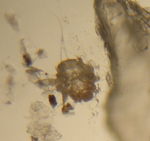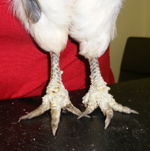Difference between revisions of "Mites"
| Line 238: | Line 238: | ||
*To aid [[Ectoparasiticides|acaricide]] penetration, clipping a dog's coat and washing is recommended | *To aid [[Ectoparasiticides|acaricide]] penetration, clipping a dog's coat and washing is recommended | ||
===''Notoedres''=== | ===''Notoedres''=== | ||
| + | |||
| + | *Known as feline scabies | ||
| + | |||
| + | *Parasite of cats, rats, man and rabbits | ||
| + | |||
| + | '''Recognition''' | ||
| + | *Similar to ''Sarcotes'' | ||
| + | |||
| + | *Less distinct angles on body surface | ||
| + | |||
| + | *Females have suckers on legs one and two | ||
| + | |||
| + | '''Pathogenesis''' | ||
| + | *Infection begins on the ear tips and spreads over the body | ||
| + | |||
*''Notoedres cati'' in [[Parasitic skin infections - Pathology#Notoedric mites|notoedric skin infestation]] | *''Notoedres cati'' in [[Parasitic skin infections - Pathology#Notoedric mites|notoedric skin infestation]] | ||
| + | |||
| + | *Causes dermatitis | ||
| + | |||
| + | '''Diagnosis''' | ||
| + | *Superficial skin scraping | ||
| + | |||
| + | *A single nest in a scraping may yield many mites | ||
==Non-Burrowing Mites== | ==Non-Burrowing Mites== | ||
Revision as of 19:13, 30 October 2008
| This article is still under construction. |
|
|
Astigmata Introduction
Mites are one of the most successful and divers vertebrate group. The species of veterinary importance are parasitic, although a few non-parasitic mites are also important, such as orbatid and forage mites.
Mites are very small, on average under 0.3mm in length and for this reason often go unnoticed. They spend the majority of their life cycle on the host and cause mange.
The taxonomy of mites is complex as there are over 8 families. In this article the families are split according to their location on the host into sub-surface (burrowing) and surface (non-burrowing) mites.
Burrowing Mites
Sarcoptidae
Sarcoptes
Recognition
- Small, round mite
- Short legs
- Project only a short distance from body margin
- Dorsal spines
- Arranged in rows
- Dorsal spines
- Terminal anus
Life Cycle
- 3 weeks life cycle
- Female lays eggs in epidermis in an egg laying pocket
- Female feeds on liquid ozzing from damaged tissue
- The eggs hatch in 1 week
- 6 legged larvae released which crawl to skin surface
- The larvae then burrow back into the epidermis into moulting pockets
- Larvae moult to become 8 legged nymphs
- Nymphs moult twice before becoming adults
- Adult males emerge and look for females for mating
Transmission
- Close contact
- Adults and larvae can be transferred from one skin surface to another
Pathogenesis
- Erthema with papule formation
- Scale and crust formation
- Alopecia
- Intense pruritis for one week
- Self-inflicted trauma
- Scab formation
- Wrinkling anf thickening of skin
- Hypersensitivity may develop
- Rash develops
- Sarcoptes scabiei
- In scabies
- Strains of S. scabiei can be passed between different animals and cause clinical signs although the infection is likely to resolve spontaneously and be unlikely to establish
Diagnisis
- Skin scraping until capillary blood appears
- Adults, eggs, immature mites and faecal pellets looked for
- Place material on a microscope slide
- Add 10% KOH
- Warm slide over bunson flame
Treatment
- Acaricide
- For more information on acaricides click here
- Treat both infected and in-contact animals
- Older products have to be given in repeat treatments
- Avermectins are effective in farm animals
- Selamectin is available as a good spot-on for dogs
- Control for pigs:
- Treat sows before entering the farrowing pen
- Treat boars at 6 month intervals
Sarcoptic Mange
Dogs
- Highly contagious
- Intense pruritis
- First signs appear at edges of ears, then progresses to muzzle, face and elbows
Cats
- Rare
Pigs
- Important condition as 35% pigs are asymptomatic carriers
- First signs of infestation appear on the ears before spreading to the rest of the body
- Transmission from sow to piglets whilst suckling and from boars to gilts at service
- Infestation adversely affects productivity
Cattle
- Most frequently seen in housed cattle
- Notifiable in USA and Canada
- Often called 'neck and tail mange' as lesions most often seen on neck and tail
- Infestation adversely affects productivity
Sheep
- Notifiable in UK
- Lesions on hairy parts of face
- E.g. Face, ears, axillae and groin
- Causes considerable hide damage in local African breeds of long haired sheep
Horses
- Notifiable in UK
- Lesions begin on head, neck and shoulders then spread to rest of body
Knemidocoptes
- Only genus of burrowing mites which occur on avian species
- Life cycle similar to Sarcoptes spp.
- Diagnosis based on clinical signs and discovery of mites
- Repeat treatments with acaricides needed
- Few products licensed for use in poultry
Recognition
- Small, round mite
- Short legs
- U-shaped chitinous bar behind head
- Terminal anus
- K. mutans
- Scaly leg in poultry
- Mites burrow beneath leg scales causing them to loosen and rise
- Ragged appearance to legs and feet
- Distorted claws and feet
- Infected birds are usually lame
- K. gallinae
- Depluming itch in poultry
- Burrow into feather shafts
- Intense pain and pruritis
- Birds pull out body feathers
- K. pilae
- Scaly face and beak in psittacines
- Mites attack bare or lightly feather areas of the face, beak, cere and body
- Scaliness at the base of the beak is the first sign which then spreads
- Little pruritis
Trixacarus
- Similar to Sarcoptes but half the size
- Causes severe pruritis in labaratory rodents
Demodex
- Demodex spp. found on all domestic mammals and on humans
- Each host has its own species
- Causes demodicosis
Recognition
- Cigar shaped
- Four pairs of stumpy legs on the anterior end
- Long and narrow to fit into hair follicles
Life Cycle
- Live as commensal organisms
- Live in hair follicles and in sebaceous glands
- Life cycle takes 3 weeks
Pathogenesis and Epidemiology
Diagnosis'
- Liquid parafin applied to a skin fold
- Deep skin scraping
Control
- Not easily accesible to acaricides due to their deep location in the skin
- Repeat treatments needed
- Recovery may take several months
- To aid acaricide penetration, clipping a dog's coat and washing is recommended
Notoedres
- Known as feline scabies
- Parasite of cats, rats, man and rabbits
Recognition
- Similar to Sarcotes
- Less distinct angles on body surface
- Females have suckers on legs one and two
Pathogenesis
- Infection begins on the ear tips and spreads over the body
- Notoedres cati in notoedric skin infestation
- Causes dermatitis
Diagnosis
- Superficial skin scraping
- A single nest in a scraping may yield many mites
Non-Burrowing Mites
Psoroptes
Psoroptes cuniculi
- Parasite of rabbits
- Epizootiology
- Common among conventional rabbits; transmitted via contact.
- Clinical
- The ears are painful and itch intensely; affected rabbits shake their heads and scratch their ears. The inner surfaces of the pinnae are covered with brown, scaly, fetid material, and the skin beneath is raw. Mites are grossly visible.
- Pathology
- Histologically, there is chronic erosive and proliferative eosinophilic dermatitis. The mites are non-burrowing and thus are found only in the exudate, not in the tissue.
- Diagnosis
- Appearance; examination for mites (low magnification).
- Control
- Infestations are difficult to eliminate from a colony, although ivermectin is said to be effective.
Chorioptes bovis
Otodectes cynotis
Cheyletiella sp.
- Cheyletiella yasguri
- In skin infestation

